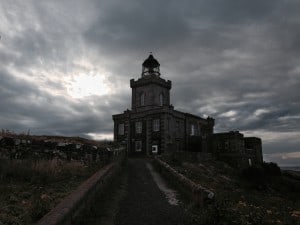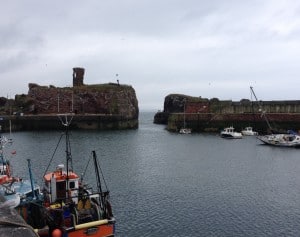We sailed from Findhorn on the Saturday with very variable fluky winds. One moment we had the spinnaker up and the next (fortunately after we had got it down) we were hit by a cloud burst and violent squall. We got only as far as the tiny harbour of Portknockie, which we squeezed into to dry out and re-group.
On Sunday we set off with extra miles to recoup. Again we had very variable winds but made progress with the spinnaker up for four hours before the wind turned contrary as we stuggled to round Frazerburgh and Rattray Head against the tide. This we achieved before the wind died completely at sunset and we had to motor the last 6nm into Peterhead harbour – the first time this season we have resorted to this.
Peterhead is a massive harbour, very busy with support vessels for the North Sea oil and gas fields. The town is dominated by the docks and very unappealing. We cycled into town and straight back out.
We had to wait until Tuesday when a good westerly wind was forecast. Actually we had calm and light airs, some from the east and some from the south and we struggled to make progress. We passed Aberdeen – a very busy port with a dozen ships anchored off waiting for space. There was a continual clatter of helicopters going to and from the off-shore rigs. For a time we were accompanied by several White-beaked Dolphins which inhabit this region. Eventually we reached Stonehaven as the wind faded completely at sunset, so we had to motor in again – the second time! Stonehaven turned out to be a delightful port with two picturesque harbours lined with small boats dried out on the sand. We had a very enjoyable meal in the Harbour Hotel.
On Wednesday we had a stiff breeze but from the south – bang on our nose. It was a long and rather hard beat all the way with no shelter until in the evening we reached St Andrews Bay. St Andrews harbour is tiny, dries and has no space for a visiting yacht but with the southerly wind we were able to anchor off in the bay. ‘Off’ is at the operative word here as the bay is very shallow and we were half a mile out from the shore.
The next morning we put the outboard on the dinghy and motored ashore to explore this delightful and ancient town. The university is the third oldest in the English-speaking world, after Oxford and Cambridge. As there, the old colleges are set around inner courtyard greens and very picturesque. It is here that many important advancements in renaissance science were made.
St Andrews is also famous as the home of golf. There are several courses here now and the town was full of golf shops and golfers. To play the Old Course bookings open in September the previous year, so we gave that a miss and saved ourselves the £150 green fee as well. Nevertheless there were coach-loads of visitors, many from overseas, queueing up for their slot. We set sail just after lunch in town, just in time to avoid rain as it swept over St Andrews, no doubt adding to the experience of golfers on the greens.
From St Andrews we had a pleasant easy sail to the Isle of May, which stands right in the middle of the entrance to the Firth of Forth and which is the only proper island on the east coast of Scotland. We anchored off and explored ashore by dinghy. This is another wildlife paradise and as we paddled ashore we were surrounded by vast numbers of sea birds (especially Shags) and seals, ever curious and swimming just 10’ behind the dinghy. It was rather noisy overnight with the crying of the seabirds and the baying of the seals. This morning as we write this, there are many hundreds of puffins out on the water with their young pufflings, swimming around the boat just feet away.

Isle of May lighthouse
The Isle of May has been a major hazard for sea farers over the centuries and was the site of the first Scottish lighthouse built back in 1635. It was coal-fired and consumed 100 tons of coal a night and as much as 300 tons during gales. In 1791 the light was out for two nights of storms and it was found that the keeper and his family had been asphyxiated by the fumes from the fire. Fortunately it was replaced by a more modern light atop a grand building, complete with a board room for the convenience of the Northern Lights Board on their inspection visits.

Dunbar harbour entrance under castle
From the Isle of May we had a gentle sail, including being becalmed for an hour, to Dunbar – an ancient small harbour on the East Lothian coast 23nm east of Edinburgh. The entrance is narrow and overshadowed by the castle, which is crumbling into the water. Mariners are warned to keep away from that side in case bits drop off. A large piece had been obstructing the entrance for some days, but had been cleared just before our arrival. As the main harbour is subject to any swell from the north, we took advantage of our shallow draft to move through a lifting footbridge and into the old harbour where we are very sheltered but dry out on the mud at low tide. We will be waiting here until four of Tony’s grandchildren arrive by train to join us on Monday.
Ynskje’s long-term friend Ettie and Jonathan live not far away and they joined us, together with Aliki and David, for drinks and nibbles. They came bearing crates containing supper, which was very welcome. We are now staying over at their house where we are being offered washing facilities and have enjoyed our first bath since mid-April!
That’s the news for now.
Ynskje & Tony
x







Hi Dad and Ynskje. Sounds like a fascinating place! We are very much enjoying you posts.
Enjoy the rest of the East Coast of Scotland.
He Ine and Tony, must be nice to meet Etty again. How are they doing?
Back in Amsterdam we had the birthdayparty of my “prince-grandchildren”: 5 years already.
So it wil be busy for you with your 4 grandchildren on board. Have a nice time with them and I keep following you.